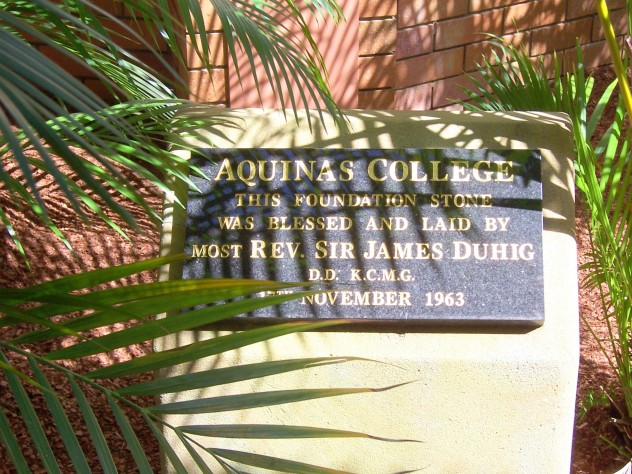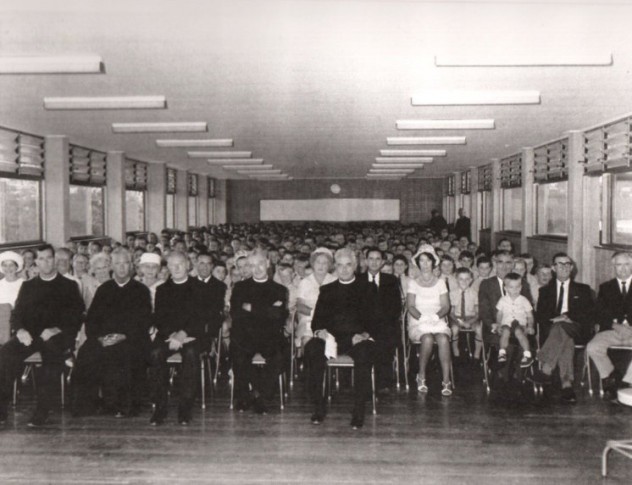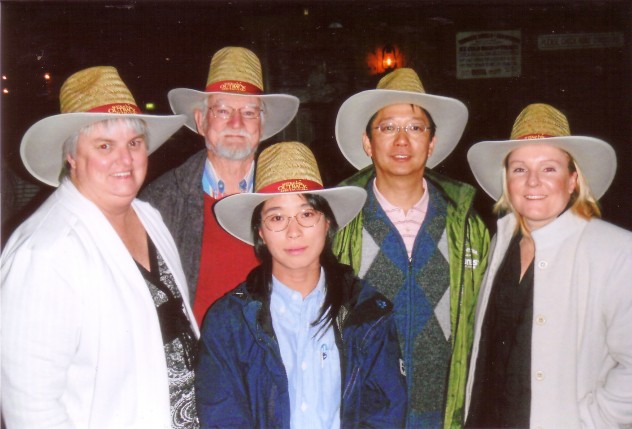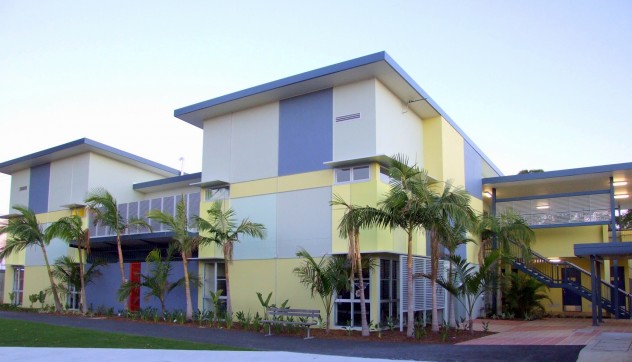Aquinas College History
1964 – 1973 The Years of Foundation
The establishment of Aquinas College, a much-needed secondary school for boys, presented one of the biggest developments in the Southport Parish in the 1960s.The college’s foundation was initiated by fourteen Catholic laymen with the cooperation of the Vincentian fathers, under the leadership of Father J.F. Duffy, Parish Priest.
 The locality for Aquinas College had originally been planned for Johnson Street, Southport, however when committee members became aware of the opening of a
new forestry reserve on Nerang Road, plans were changed. The location of the college brought much debate, as some thought that it was too far out of town. Although planning and negotiations were started much earlier, it wasn’t until 17 November 1963 that the college’s foundation stone was laid by Archbishop Sir James Duhig, on 39.5 acres of land leased at £90 per annum, convertible to freehold within five years. The Christian Brothers had given a guarantee to staff the school, and it opened its doors in 1964. Built by Mr Bill Short and Mr Bill Mann, the College and the Brothers’ Residence were completed late in 1963, costing approximately £150,000 for Stage 1.
The locality for Aquinas College had originally been planned for Johnson Street, Southport, however when committee members became aware of the opening of a
new forestry reserve on Nerang Road, plans were changed. The location of the college brought much debate, as some thought that it was too far out of town. Although planning and negotiations were started much earlier, it wasn’t until 17 November 1963 that the college’s foundation stone was laid by Archbishop Sir James Duhig, on 39.5 acres of land leased at £90 per annum, convertible to freehold within five years. The Christian Brothers had given a guarantee to staff the school, and it opened its doors in 1964. Built by Mr Bill Short and Mr Bill Mann, the College and the Brothers’ Residence were completed late in 1963, costing approximately £150,000 for Stage 1.
 As he laid the foundation stone of the new college, Archbishop Duhig said, “I feel confident that there will be a big future before the school here, both in the number of pupils and in the quality of education given.” Situated in the new suburb of“Roryville”, the college opened on 28 January, 1964, with 132 students enrolled, with three teachers under Brother R.B. Murphy as Principal. St Paul’s was the favoured name for the college, but Archbishop Duhig decided on Aquinas. From that time on, there was a constant need for expansion and completion of new facilities to cope with its rapid growth.
As he laid the foundation stone of the new college, Archbishop Duhig said, “I feel confident that there will be a big future before the school here, both in the number of pupils and in the quality of education given.” Situated in the new suburb of“Roryville”, the college opened on 28 January, 1964, with 132 students enrolled, with three teachers under Brother R.B. Murphy as Principal. St Paul’s was the favoured name for the college, but Archbishop Duhig decided on Aquinas. From that time on, there was a constant need for expansion and completion of new facilities to cope with its rapid growth.
Father Keith Turnbull, appointed Parish Priest during the first year of the school, was highly supportive of the Brothers. He organised a Parish Council and committees, including two for education and fundraising. Art Union houses were built and raffled to raise much-needed funds for parish developments, but the bulk of the £90,000 school debt was borne by the Southport Parish, which established Catholic Education as a priority.
The top oval was completed in 1964 and celebrated by the whole parish. In 1968, Brother Murphy’s last year, classes ranged from Grades 5 to 12, with tuition fees costing $42 per student, and a school population of 386 students. The positions of college captain and supporting prefects were founded and a financial agreement reached with the parish. Brother Murphy must have had great satisfaction in being able to look back on the very solid foundation he had established for Aquinas College.
1974 – 1983 Education with the Brothers
Records of the early days of Aquinas stressed the values of typical Christian Brothers’ colleges. Emphasis was placed on hard work in all things educational, physical and spiritual. Records were kept of exam successes, sporting awards and school activities. It was certainly hard work for the Brothers. Classes in the early days averaged fifty pupils, with no non-teaching periods for teachers, but the Brothers enjoyed a simple unity of purpose.
 1974 saw more changes at Aquinas. As well as the change to an eight-period day, a third Year Eight class was added, and some non-academic subjects were provided for students. In lower secondary grades, Speech, Music, Art and Physical Education were studied by every student. Grade 10 boys could study Business Principles and ‘Board Subjects’ were introduced in Grades 9 and 10. Brother M. Felix Ziesing (Principal from 1973 – 1978) was especially interested in Manual Arts being introduced.
1974 saw more changes at Aquinas. As well as the change to an eight-period day, a third Year Eight class was added, and some non-academic subjects were provided for students. In lower secondary grades, Speech, Music, Art and Physical Education were studied by every student. Grade 10 boys could study Business Principles and ‘Board Subjects’ were introduced in Grades 9 and 10. Brother M. Felix Ziesing (Principal from 1973 – 1978) was especially interested in Manual Arts being introduced.
Brother L. Gerard Massingham was principal from 1979 to 1984. The college grew both numerically and physically during this time. Many buildings were completed: six classrooms, a primary library, a computer room, with major extensions to the staff room, administration block and manual arts building. Out of doors there were two new ovals, complete reconstruction of the front lawns and a variety of sporting facilities.
 During all this development, the Southport Parish alone bore the financial burden of running the college. At its height, six houses, eight cars and two luxury boats were drawn
each year in the parish’s art unions. These were a mammoth undertaking that continued, not without risk, for more than two decades, supplemented by twice-weekly bingo sessions. A Mothers’ Club also met at the college one morning a month, raising money needed to erect tennis courts at the school. Even during lean times, the parish supported three schools as well as normal parish activities, one of the schools being Aquinas College.
During all this development, the Southport Parish alone bore the financial burden of running the college. At its height, six houses, eight cars and two luxury boats were drawn
each year in the parish’s art unions. These were a mammoth undertaking that continued, not without risk, for more than two decades, supplemented by twice-weekly bingo sessions. A Mothers’ Club also met at the college one morning a month, raising money needed to erect tennis courts at the school. Even during lean times, the parish supported three schools as well as normal parish activities, one of the schools being Aquinas College.
1984 – 1993 Aquinas Becomes Co-educational
1984 saw Aquinas College reach its peak enrolment of 707 students, requiring a staff of fifty to administer the school. After this time, the development pattern of the school changed. Other Catholic schools opened on the Gold Coast and the opening of Guardian Angels Primary School, adjacent to the college, meant that Aquinas became a secondary school only.
As a Parish school, Aquinas College had been conducted by the Christian Brothers from its foundation in 1963 until 1987. In 1988, with the Brothers’ numbers diminishing, the Brothers withdrew, and the administration of Aquinas was taken over by the Catholic Education Office in Brisbane.
 Also in 1988, the Mary Immaculate Church opened across the road from the college. Aquinas College entered a new era with the appointment of its first lay principal, Mr Ed Riley. At this time, the college’s enrolment was 440 boys.
Also in 1988, the Mary Immaculate Church opened across the road from the college. Aquinas College entered a new era with the appointment of its first lay principal, Mr Ed Riley. At this time, the college’s enrolment was 440 boys.
One of the most dramatic and controversial announcements in the history of the Parish was made in 1990, when the Sisters of Mercy announced the closure of Star of the Sea College. To cope with the needs of the education of girls, Aquinas College became a co-educational school, with the first girls attending in 1991. This demanded a huge financial commitment of the parish to building projects, remodeling old facilities and building of new ones (including a new library completed in 1990). Under the leadership of Aquinas’ second lay principal, Mr Terry Enright, the college’s enrolment rose again to over 600 students.
The college was now part of the Southport Catholic Centre that included Aquinas College and Guardian Angels Primary School, four ovals, the parish church (Mary Immaculate), the presbytery and Catholic Centre and a hostel for aged persons (De Paul Villa).
1994 – 2003 A Time for Consolidation
Throughout the 1990s, Aquinas College continued to establish itself as a leading coeducational school on the Gold Coast. A gradual increase in the school population brought with it higher academic and sporting standards, as exemplified by the increasing numbers of students gaining tertiary places and some outstanding individual and team performances in various sports, the most notable of these being a record nine successive victories at the Broadwater Swimming Carnival.
In 1998, Mr Terry Enright resigned as Principal, having overseen a productive period of the college’s history. He was replaced in 1999 by Sr Nancy Freddi, a Sister of Mercy from Victoria, who brought with her a wealth of educational and administrative experience.
From day one, Sr Nancy sought to bring positive changes to the college and, having overseen a review of the school and its practices, refurbished the administration and staffroom areas, the Science laboratories, Middle School area and, with the assistance of the P & F, resurfaced the undercover area.
Significant changes have occurred also in the areas of Vocational Education and Technology. Aquinas students now have “multiple pathways” to employment through school-based traineeships and the ability to complete many nationally recognised training courses while still at school. The students also have access to ‘state of the art’ technology: there are around three hundred fully networked computers in the college, a number of wireless access points and remote access to the server available from home.
Aquinas College was now at the forefront of educational technology and opportunities and, as the new millennium dawned, all members of the Aquinas community looked forward to an exciting and fruitful future.
2004 – 2013 The Fifth Decade
 In this decade, Aquinas College moved rapidly into a period of consolidation and development. New buildings and renovations have been undertaken as the college caters for a wider curriculum for both boys and girls. Student numbers grew significantly during this period. In 2013, another major building program was launched to prepare for the arrival of Year 7 students in 2015, which would further increase student numbers.
In this decade, Aquinas College moved rapidly into a period of consolidation and development. New buildings and renovations have been undertaken as the college caters for a wider curriculum for both boys and girls. Student numbers grew significantly during this period. In 2013, another major building program was launched to prepare for the arrival of Year 7 students in 2015, which would further increase student numbers.
The usual year group structure for home or pastoral groups of students shifted to a Vertical Pastoral Care program, made up of about 25 students from Years 8 – 12 in each homeroom belonging to one of the four houses. This structure allows older students to provide leadership and support from younger students. Students develop a strong sense of their pastoral care group, house and home teacher over their five years at the college. Another major development during this time was the shift from students using desktop computers to one-on-one portable MacBooks. By 2013, all students had use of a personal MacBook.
In 2004, Principal Sr Nancy Freddi RSM completed her final year at Aquinas College. She wrote, “I have seen young people expanding the horizons, seeing things in new ways, learning new perspectives and gaining an increased understanding of themselves and others as they have matured.” Sister Nancy led the college during the 40th year celebrations.
 Mrs Maryanne Finder became the new Aquinas College principal in 2005. One of her favourite slogans has been: ‘Happy + safe = quality learning’. During her time as principal, Mrs Finder actively promoted student immersion experiences overseas, for example to Indonesia and Japan.
Mrs Maryanne Finder became the new Aquinas College principal in 2005. One of her favourite slogans has been: ‘Happy + safe = quality learning’. During her time as principal, Mrs Finder actively promoted student immersion experiences overseas, for example to Indonesia and Japan.
Fr Peter Dillon arrived as the new parish priest, staying from 2006 to 2013. World Youth Day 2008 in Sydney was a memorable event for staff and senior students, as was the pilgrimage of the World Youth Day cross in 2007.
On 17 November 1964, the Aquinas College’s foundation stone was laid. 50 years later, in November 2013, this moment was remembered in an informal ceremony in front of the foundation stone, now located outside the college library.
 During this fifth decade, Aquinas has evolved into a quality contemporary educational Catholic college. It has retained much of its original vision, yet has also adapted to the times, as it faces the challenges of the present day. Aquinas continues to build on the riches of the past in its people, educational and extracurricular achievements, its history and its faith, as expressed in the college motto ‘Pro Deo’. The future of Aquinas College is one of confidence and hope.
During this fifth decade, Aquinas has evolved into a quality contemporary educational Catholic college. It has retained much of its original vision, yet has also adapted to the times, as it faces the challenges of the present day. Aquinas continues to build on the riches of the past in its people, educational and extracurricular achievements, its history and its faith, as expressed in the college motto ‘Pro Deo’. The future of Aquinas College is one of confidence and hope.
